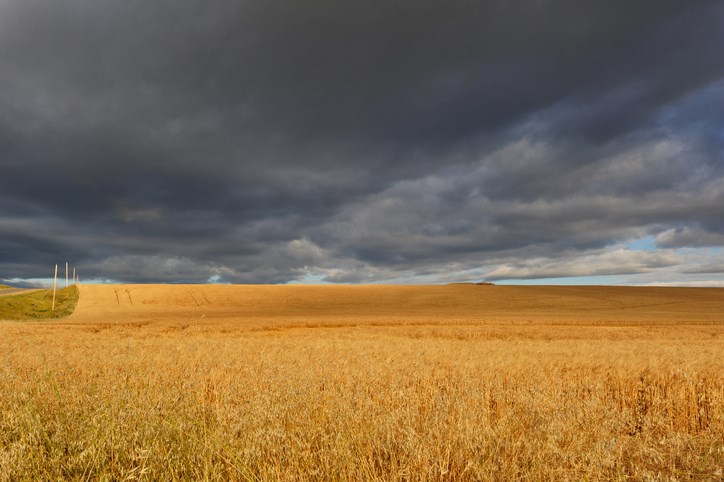Western Canadian farmers can’t catch a break this year.
It is bad enough that a severe lack of moisture in June and July decimated yields.
Now there are mounting concerns that the rains that finally arrived in the last half of August are causing quality damage.
“It is concerning for sure,” said Daryl Beswitherick, program manager for national inspection standards with the Canadian Grain Commission.
“We are definitely going to keep our eyes on it.”
A large swath of the prairie region received significant rain during the last half of August.
“It was kind of unfortunate that we got that much rain at kind of the wrong time of year but that’s farming in Western Canada,” he said.
Beswitherick works in Winnipeg, which got 32 millimetres of moisture in just one or two days. He wonders if more is on the horizon.
“There is an old farmer saying that whatever you don’t get off in August you’ll take off in October because September can be a wet month,” he said.
He estimates 60 to 70 percent of the prairie crop was still in the field during the late-season downpour.
Elevator staff and other grain buyers are telling him that the rains have caused quality issues.
“We are starting to see wheat that’s sprouting and some of it is enough to drop it into feed wheat,” said Beswitherick.
Sprouting tends to happen when mature crops get rain in August followed by hot temperatures and that is exactly what happened.
Much of the pulses were already in the bin by the time the rains arrived but for those crops that were still out in the field, there could be some wrinkling and discoloration.
Hard vitreous kernels may be washed out of the hard red spring wheat and durum crops, while there could be some staining and pre-germination happening in malt barley fields.
Crops can often lose a grade or two under these circumstances, he said.
Kevin Hursh, executive director of the Inland Terminal Association of Canada, said while no farmer wants to lose a grade or more, it likely won’t result in a huge financial blow.
“It’s a year when the quality makes amazingly little difference,” he said.
No. 1 durum is fetching $21 per bushel this year, while No. 4 or No. 5 is getting about $20. No. 1 CWRS wheat is selling for $11 per bu. compared to $10 for feed wheat.
“The feed (demand) has brought the bottom end up so much that quality in some of the crop is not the typical spread,” said Hursh.
The usual discount for feed quality wheat versus top quality would be 50 to 60 percent.
He said there is also some strange downgrading happening this year. His brown mustard is all No. 4 due to sprouting in a drought year. And his crop came off well before the August rain.
Tiny, mature kernels dried up and sat in the pod while the rest of the crop was maturing. Even a small morning dew was enough to cause 10 percent germination in his mustard. That will be difficult to blend away.
Hursh said this will also be a year where protein premiums are minimal to non-existent.
“When your protein is higher than your bushels per acre you don’t usually get a premium for it,” he said.
The Canola Council of Canada warns that the late rains have also resulted in canola regrowth in parts of the Prairies. Experts recommend desiccating or swathing the regrowth while the crop is still standing.
“Moisture-sucking winter annual weeds have also been spotted in the same regions,” the council said in a recent Canola Watch publication.
While some crop downgrading is likely, Beswitherick isn’t prepared to jump to any conclusions about how widespread it will be just yet because he hasn’t seen any of the rain-damaged material come through the CGC’s Harvest Sample Program.
He does not want to “ring any alarm bells” until he has had a chance to look at those samples. There are new varieties on the market that have improved sprout resistance.
“We’re still holding out hope that (the wheat) might not look quite as pretty and nice and red but the sprouts will stay away,” he said.
He also noted that the rains were likely beneficial for late-seeded crops like soybeans, corn and sunflowers.
Beswitherick said that even if a farmer loses a grade it won’t be the end of the world. Lentils are exported as No. 2 or better quality while the vast majority of Canadian wheat is sold as No. 2.
He said it will be crucial for farmers to provide the CGC and grain companies with good representative samples of their crops so they are not caught off guard in the grading process.





